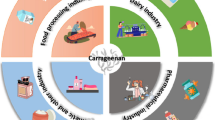Abstract
The effects of aqueous extracts from Microcysts aeruginosa strains (both microcystin-producers and non-microcystin producers) on germination and root growth were investigated for three economically important plant species: Festuca rubra L., Lolium perenne L., and Lactuca sativa L. There was a clear inhibition of root growth for L. sativa exposed to strains containing microcystins (5.9–56.4 μg L−1). The strain that produced the most pronounced effects contained the lowest concentration of microcystin suggesting that other cellular compounds may also affect growth.

Similar content being viewed by others
References
Carmichael WW (1992) Cyanobacteria secondary metabolites–the cyanotoxins. J Appl Bact 72:445–459
Codd GA, Edwards C, Beattie KA, Lawton LA, Campbell DL, Bell SG (1995) Toxins from blue-green algae. The Pringsheim lecture. In: Wiessner W, Schnepf E, Starr RC (eds) Algae, Environment and Human Affairs. Biopress, Bristol, pp 1–17
Codd GA, Metcalf JS, Beattie KA (1999) Retention of Microcystis aeruginosa and microcystins by salad lettuce (Lactuca sativa) after spray irrigation with water containing cyanobacteria. Toxicon 37:1181–1185. doi:10.1016/S0041-0101(98)00244-X
Hamvas MM, Mathe C, Molnar E, Vasa G, Grigorsky I, Borbely G (2003) Microcystin–LR alters the growth, anthanocyanin content and single-stranded DNase enzyme activities in Sinapsis alba L. seedlings. Aquat Toxicol 61:1–9. doi:10.1016/S0166-445X(01)00273-9
Jones GJ, Orr PTY (1994) Release and degradation of microcystins following algicide treatment of a Microcystis aeruginosa bloom in a recreational lake as determined by HPLC and protein phosphatase inhibition assay. Water Res 28:871–876. doi:10.1016/0043-1354(94)90093-0
Kós P, Gorzó G, Surányi G, Borbély G (1995) A simple and efficient method for isolation and measurement of cyanobacterial hepatotoxins by plant tests (Sinapsis alba L). Analyt Biochem 225:49–53. doi:10.1006/abio.1995.1106
Kuiper-Goodman T, Falconer I, Fitzgerald J (1999) Human health aspects. In: Chorus I, Bartram J (eds) Toxic cyanobacteria in water. E & FN Spon, London, pp 113–153
Kurki–Helasmo K, Meriluoto J (1998) Microcystin uptake inhibits growth and protein phosphatase activity in mustard (Sinapsis alba L.) seedlings. Toxicon 36:1921–1926. doi:10.1016/S0041-0101(98)00114-7
LeBlanc S, Pick FR, Rodriguez RA (2005) Allelopathic effects of the toxic cyanobacterium Microcystis aeruginosa on Duckweed, Lemna gibba L. Environ Toxicol 20(1):67–73. doi:10.1002/tox.20079
MacKintosh C, Beattie KA, Klumpp S, Cohen P, Cood GA (1990) Cyanobacterial microcysyin–LR is a potent and specific inhibitor of protein phosphatases 1 and 2A from both mammals and higher plants. FEBS Lett 264:187–192. doi:10.1016/0014-5793(90)80245-E
McElhiney J, Lawson LA, Leifert C (2001) Investigations into the inhibitory effects of microcystins on plant growth, and the toxicity of plant tissues following exposure. Toxicon 39:1411–1420. doi:10.1016/S0041-0101(01)00100-3
Mitrovic SM, Pflugmacher S, James KJ, Furey A (2004) Anatoxin-a elicits an increase in peroxidase and glutathione S-transferase activity in aquatic plants. Aquat Toxicol 68:185–192. doi:10.1016/j.aquatox.2004.03.017
Pflugmacher S (2002) Possible allelopathic effects of cyanotoxins with reference to microcystin–LR, in aquatic ecosystems. Environ Toxicol 17:407–413. doi:10.1002/tox.10071
Romanowska-Duda Z, Tarczynska M (2002) The influence of microcystin-LR and hepatotoxic cyanobacterial extract on the water plant Spirodela oligorrhiza. Environ Toxicol 17(5):434–440. doi:10.1002/tox.10076
Rositano J, Nicholson BC (1994) Water treatment techniques for removal of cyanobacterial toxins from water. Australian Centre for Water Quality Research, Salisbury, p 55
Sivonen K, Jones G (1999) Cyanobacterial toxins. In: Chorus I, Bartram J (eds) Toxic cyanobacteria in water. E & FN Spon, London, pp 41–111
Ueno Y, Nagata S, Tsusumi T, Hasegawa A, Yoshida F, Sutajjit M, Mebs D, Vasconcelos V (1996) Survey of microcystins in environmental water by a highly sensitive immunoassay based on monoclonal antibody. Nat Toxins 4:271–276
Vasconcelos VM, Sivonen K, Evans WR, Carmichael WW, Namikoshi M (1995) Isolation and characterization of microcystins (heptapeptide hepatotoxins) from Portuguese strains of Microcystis aeruginosa Kutz emed Elekin. Arch Hydrobiol 134:295–305
Weiss J, Liebert HP, Braune W (2000) Influence of microcystins-RR on growth and photosynthetic capacity of the duckweed Lemna minor L. J Appl Bot 74:100–105
Author information
Authors and Affiliations
Corresponding author
Rights and permissions
About this article
Cite this article
Pereira, S., Saker, M.L., Vale, M. et al. Comparison of Sensitivity of Grasses (Lolium perenne L. and Festuca rubra L.) and Lettuce (Lactuca sativa L.) Exposed to Water Contaminated with Microcystins. Bull Environ Contam Toxicol 83, 81–84 (2009). https://doi.org/10.1007/s00128-009-9763-z
Received:
Accepted:
Published:
Issue Date:
DOI: https://doi.org/10.1007/s00128-009-9763-z




